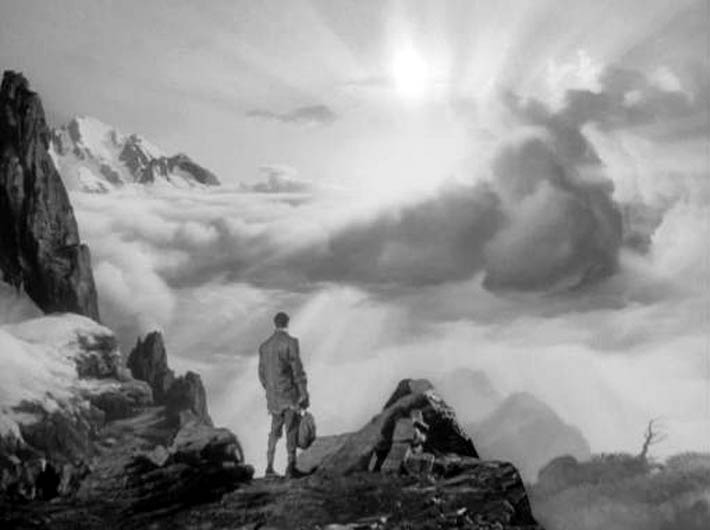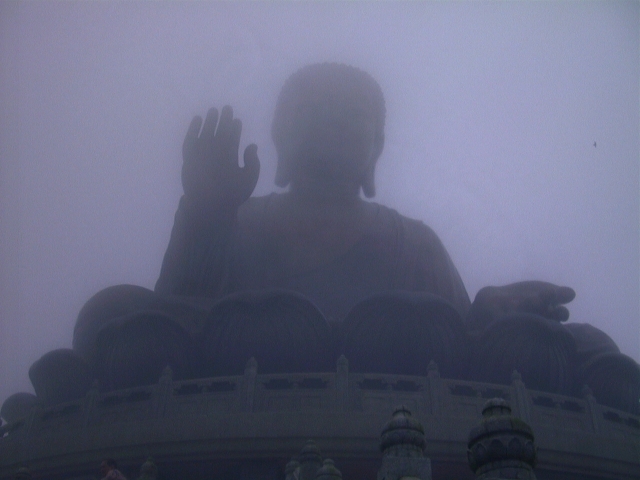"Buddhism teaches that after a practitioner achieves a certain degree of realization, spiritual power develops. Furthermore, it is acknowledged as well that supernatural powers are not attainable exclusively JUST by Buddhists and Buddhists only, but possible for anyone who has deep religious and spiritual cultivation to develop some kind of 'supernormal powers.'"
"If a Bhikkhu should desire, Brethren, to exercise one by one each of the different Siddhis: being one to become multiform, being multiform to become one; to become visible, or to become invisible; to go without being stopped to the further side of a wall, or a fence, or a mountain, as if through air; to penetrate up and down through solid ground, as if through water; to walk on the water without dividing it, as if on solid ground; to travel through the sky like the birds on wing; to touch and feel with the hand even the sun and the moon, mighty and powerful though they be; and to reach in the body even up to the heaven of Brahma; let him then fulfil all righteousness, let him be devoted to that quietude of heart which springs from within, let him not drive back the ecstasy of contemplation, let him look through things, let him be much alone!"
"According to the Buddha and how the sutras are said to present it, to manifest or execute the abilities of Siddhis, a strigent regimen of meditation and concentration MUST meet certain levels of accomplishments. To reach such a level the meditator must be perfect in the precepts (Sila), bring his thoughts to a state of quiescence (Samadhi), practice diligently the trances (Jhana), attain to insight (Prajna) and be frequenter to lonely places. The question is how many people meet such criteria, that is, being masterful in Sila, Samadhi, Jhana, and Prajna and be frequenter to lonely places?"
Parkaya Pravesh means entering oneís soul in the body of some other person. Through this knowledge even a dead body can be brought to life.
Just about three thousand years back, Shankaracharya had to take help of this knowledge in order to defeat Mandan Mishra in a spiritual debate. But as time passed this knowledge became extinct in the society and today only a very few yogis have full practical knowledge of this unique practice.
This Vidya or knowledge has been mentioned in several ancient texts. On acquiring this Vidya a person neither feels hungry nor thirsty and he can remain without eating food or drinking water for several days at a stretch.
Several Yogis of the Himalayas, remain engrossed in deep Sadhanas for months and years without eating or drinking anything. When they do not eat or drink, they do not even have to empty their bowels. Thus they are able to perform long penance for years and their bodies also remain healthy and fit, even without food. The mysterious wandering Digambara monk Trailanga Swami was proficient in this Vidya. Although not always counted among Siddhis per se' several instances have been cited regarding Trailanga Swami's ability to spend hours under the water of the Ganges as he sought to teach men that human life need not depend on oxygen under the auspices of certain spiritual conditions and precautions (Pranayama). It has been reported there is a yogi that lives on the peak of the holy mountain Arunachala that has not had anything to eat since 1990. See also Nirodha.
Just as one does not feel hungry or thirsty in Haadi Vidya similarly in Kaadi Vidya a person is not affected by change of seasons i.e. by summer, winter, rain etc. After accomplishing this Vidya a person shall not feel cold even if he sits in the snow laden mountains and shall not feel hot even if he sits in the fire. Thus a Sadhak can perform incessant penance without being affected by change of weather or seasons.
On accomplishing this Vidya, a person becomes capable of increasing or decreasing the size of his body according to his wish. Lord Hanuman had miniaturised his body through this Vidya while entering the city of Lanka.
The average height of a human being is six feet. Through this Vidya a person can reduce the size of his body to the size of a mosquito and can even enlarge his body to a size of over hundred feet.
Anima Siddhi - The ability to decrease the size of one's body and become smaller than the smallest particle. Through this siddhi one may enter into stone or change the density in one's body, enabling one to pass through solid matter.
Mahima Siddhi - The ability to increase the size of one's body, ultimately enveloping the universe.
Through this Siddhi a person can become capable of flying in the skies and traveling from one place to another in just a few seconds. The Jain scriptures speak of Jain ascetics who could fly from place to place in a few seconds. Although there are several occasions of individuals flying reported in the Sutras of classical Buddhism and Zen, the Venerable Pindola Bharadvaja is probably the person most commonly cited. For the movement or cross-transference of items between the conventional plane or physical plane and other possible environments see Apportation Revisited.
Swami Vishuddhanandji (d. 1937)(sometimes spelled: Vishuddhananda, Vishudhanandaaka; aka: Gandha Baba, Perfume Saint), well-known for his supernatural powers and said to be an adept associated with the mysterious Gyanganj (Jnanaganj) hermitage somewhere in Tibet -- a secret place of great masters -- demonstrated this practice in Varanasi and proved that it is not a myth. It is said long life spans are associated with Gyanganj and, as with the digambara Siddhi master Totapuri, Swami Vishuddhanandji was reputed to have lived 300 years. The problem most seekers along the path have with Gyanganj, also known as Shangri-La and Shambhala, is that, for westerners especially, it is always from some ancient past that it ever gets recognized as existing, especially so when it comes to actual access. When there are modern versions they are always ambiguous. There is, however, a somewhat more recent modern day account for those who may be so interested. See:
SHANGRI-LA, SHAMBHALA, GYANGANJ, BUDDHISM AND ZEN
Although throughout his life the Enlightened sage Bhagavan Sri Ramana Maharshi never exhibited the slightest interest in Siddhis, occult abilities, or psychic powers to outsiders, he had a fully conscious bilocation experience he rarely discussed wherein he was translocated from his ashram in a matter of minutes to a devotee many, many miles away. Arthur Osborne, Ramana's biographer writes in Ramana Maharshi And The Path of Self-Knowledge (York Beach: Samuel Weiser, Inc., 1995, pages 96-97):
"One day, some years ago, I (Sri Ramana) was lying down and awake when I distinctly felt my body rise higher and higher. I could see the physical objects below growing smaller and smaller until they disappeared and all around me was a limitless expanse of dazzling light. After some time I felt the body slowly descend and the physical objects below began to appear. I was so fully aware of this incident that I finally concluded that it must be by such means that Sages using the powers of Siddhis travel over vast distances in a short time and Appear and Disappear in such a mysterious manner. While the body thus descended to the ground it occurred to me that I was at Tiruvottiyur though I had never seen the place before. I found myself on a highroad and walked along it. At some distance from the roadside was a temple of Ganapati and I entered it."
A second equally interesting incident, cast in in a similar vein, and involving the Maharshi but a little too long to put here, can be found by going to: THE MEETING: An Untold Story of Sri Ramana
Laghima Siddhi - The ability to make one's body lighter than air and fly at will. The perfection of this siddhi enables one to travel on the sun's rays and enter into the sun planet.
LAGHIMA: TO HAVE NO WEIGHT. Laghima is the control of the effect of the earth's attraction on the body by developing in each cell the opposite (centrifugal) tendency. Said to be implemented for the performed act of levitation, the Vayu Gaman Siddhi and the Laghima Siddhi. According to one of the eighteen main Puranas, the Markandeya Purana, Laghima means "to have an extreme speed."
Successful cultivation of even the earliest stages of Samadhi can result in entering into the sublime meditative states of the Five Jhana Factors of which one is called Piti. Inturn Piti is broken down into five levels. One of those levels is called Ubbenga Piti, known as the transporting rapture.
Ubbenga Piti can lift the body off the floor and doing so still occurs to meditators of current times both in Thailand and elsewhere. A strong rapture of this kind, as manifested through the higher Jhana states, is able to lift the body and transport it (fly) over great distances through the air.
One can acquire immense and unlimited wealth through this Siddhi. Itís said that once Shankaracharya saw a very poor and destitute woman and with the help of the Kanakdhara Yantra he showered gold in her house. This Yantra is made on a silver plate and 36 squares are formed by drawing 7 lines each, horizontally and vertically. Then the Beej Mantra is written in these squares. Today only a very few people have full and authentic knowledge of this Siddhi.
Through this Sadhana a yogi can direct his disciple to take birth from the womb of a woman, who is childless or cannot bear children. Several Yogis have thus blessed infertile women with children. Swami Vishuddhanand had accomplished this Sadhana and had used it to bring happiness into the lives of several women. But today only two or three persons are accomplished in this Sadhana.
This Solar science is one of the most significant sciences of ancient India. This science has been known only to the Indian Yogis and using it, one substance can be transformed into another through the medium of sun rays.
Swami Vishudhananda had demonstrated the miracles of this science about 50-60 years ago, by transforming a paper into rose and a cotton ball into gold, otherwise it has become almost extinct.
This Vidya was created by Adi Shankaracharya. Through it even a dead person can be brought back to life. This practice may seem to be a myth but it had been used by Guru Gorakhnath several times. Today only a few persons have practical knowledge of this Vidya.
Prapti Siddhi - The ability to manifest any object one desires within one's hand. This siddhi removes the limitations of space which seperate two objects from each other. It is said one will even be able to touch the moon with one's finger [i.e. the limitation of distance is removed].
Prakamya Siddhi - The ability to attain anything one desires.
Ishita Siddhi - The ability to control the sub-potencies of the laws of nature. This enables one to control various energies and seemingly defy the laws of nature. The Swami Ramalinga, more popularly known as Vallalar is recorded to have moved a whole contingent of followers from the wrath of a terrible storm to the safe harbor of a distant shrine in an instant. See also la Catalina whose abilities allowed her, among other things, to turn into a wisp of smoke as though a blackened silhouette and sail through the air only to dissipate into the night sky. See also White Light Shields as well as The Curandero.
Vashita Siddhi - The ability to bring others under one's control.
Kamavasayita Siddhi - The ability to attain anything anywhere. This is the highest of the eight and contains most of the abilities of the other perfections.
In the Yoga Sutras of Patanjali, Chapter IV, verse 1 it is stated as well that the supernormal perceptual powers of Siddhis CAN be reached through the use of certain herbs, that is DRUGS, called Aushadhis in Sanskrit, replicating on the short term a mind-strength ability and potential execution of powers similar to or equal to that of a person versed in Siddhis garnered via the highest levels of Spiritual Attainment. See:
AUSHADHIS: AWAKENING AND THE POWER OF SIDDHIS THROUGH HERBS
The translators of Yoga Sutras of Patanjali, as found in the text from the source so cited, of the First Verse of Pada 4 (Kaivalya Sutra) 1, offer the following commentary in interpretation of the meaning behind the translation in regards to aushadhis (i.e., drugs):
(O)ne's latent abilities become enhanced through the wise utilization and communion with nature's medicines and elixirs (aushadhi) which in turn trigger/activate the inner evolutionary circuits (including the body's neuro-endocrine system), clear out obstructions in the nadis, and in general remove obstructions both in the cellular memory and neuro-psychic pathways. The wise use of certain herbal combinations are known to the tradition of yoga to stimulate/catalyze the production of inner elixirs (soma, amrita, etc.) which are also activated by other factors.(source)
One's latent abilities means quite frankly how far along the path one has become masterful in Sila, Samadhi, Jhana, Prajna, and being a frequenter to lonely places. There cannot be significant results with Siddhis under any circumstances, with or without aushadhis or anything else, IF one's latent abilities are lacking because there is just nothing to draw upon. The level of latent abilities that exist within is what is enhanced. Again, if miniscule, then miniscule, if all but the bottom of the barrel breaking through, then close to major.(see)
AND NOW THIS:
It should be noted the Collection of Long Discourses, Diigha Nikaaya, in the Sampasaadaniiya Sutta, makes it clear Siddhis are, depending on who or how or why they are implemented, divided into two types, one of which is termed ignoble and the other noble. Siddhis are labeled ignoble if the intent of the practitioner is concomitant with mental intoxicants and worldly aims. In other words, it is possible to employ the fruits of the Siddhis in such a manner that the mundane world, rather than being transcended, becomes even more attractive and one's involvement within it is deepened even further. Siddhis produced through Manomaya Kosha may become the occasion of a descent into the actual or phenomenal world rather than ascent into the real or noumenal.(source)
The Buddha was well aware of the fact that there are those who devote themselves to meditation exercises for no other reason than to acquire supernatural powers. The Buddha refined the meditative practice for devotees by telling them that acquisition of supernatural powers does not confer any special spiritual advantage. It was for this reason that he forbade his disciples to work miracles for display. Craving for supernatural powers and taking delight therein after Acquirement does not help to free one from The Three Poisons. It is advised that anyone striving along the path of holiness toward final liberation guard themselves to not get caught up in it all and forget the true purpose.(see)
In the world generally, the common inclination is to judge the merits and ability of a Sadhu through his Siddhis. It is a blunder indeed. They should not judge the Enlightenment of a Sadhu in this way. Siddhis are by-products of concentration. Siddhis have nothing to do with Self-realization. A Sadhu may manifest Siddhis due to strong passions and intense desires, and if that be the case, he is undoubtedly a big householder only. Siddhis are a great hindrance to spiritual progress, and so long as one is within the realm of Siddhis and does not try to rise above it and march onwards, there is not the least hope of God-realisation. But, this does not mean that a person manifesting Siddhis is not a realized soul. There are several instances of such persons who have exhibited several Siddhis purely for the elevation and uplift of the world, but never for selfish motives. (source)
SIDDHIS: SUPERNORMAL PERCEPTUAL STATES
H.G. WELLS: THE TIME MACHINE
CLICK EITHER OF THE VERSIONS SHOWN BELOW
MEDITATION APPS

The past several years has seen a proliferation of smartphone meditation apps come on the market, all designed in such a way to ease, assist, familiarize, and put into use meditation techniques for almost anybody interested in learning and implementing the various ins-and-outs of meditation, at least as the manufacturers of the apps view meditation.
Beyond the manufacturers advertisement and promotions, for every page that shows up on the internet or elsewhere in support of using the apps, there is an equal number of pages knocking their use. What the knocking their use people are selling varies, but the in support folk seem to be in line with the app builders and promoters because if nothing else, the apps sell --- and sell big time, especially so the two top brands, Headspace and Calm.
People use all kinds of things to enhance or increase their ability to accomplish things. They wear glasses to improve the clarity of their physical vision. Some use dental implants and dentures to chew, eat, or look better. The same for the use of prosthetics, crutches, canes, or wheelchairs. They help people get things done and walk or move about who otherwise might not be able to. But, if glasses to read or see aren't needed, or implants or dentures, or canes, crutches, or wheelchairs, why use them? Initially, with meditation, other than a coming to know what meditation is and what it can do if you do it, nothing much than the desire to do so and then doing it is required Painting legs on a snake doesn't make it walk any better. Electronically painting photon-pushing meditation legs to swath your synapses with trompe l'oeil may be for some, better than nothing. However, and this is one of the biggest however's ever, it is that better than nothing that makes it not, not nothing, the goal of meditation.
 -----
-----


